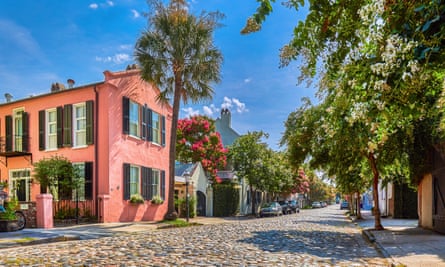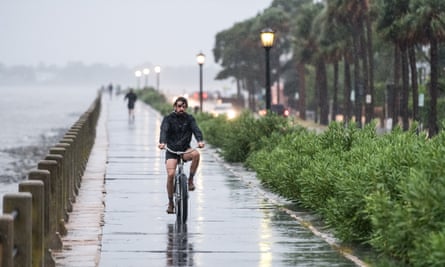Predictions about how much water is coming vary greatly. Some scientists say we should be planning on three feet of rise by 2050, six feet by 2070 and 10 feet by 2100. Someday, not too long from now, the stories of many current coastal and riverside cities across the US will include sudden plot twists as well as new beginnings, as edges that had seemed solid liquify and become indistinguishable from the seas around them.
That brings us to Charleston, South Carolina. Its geography is that of a small New York City. The city also has a history of racial immorality, often ignored by its contemporary boosters.
About 40% of all the enslaved people who were forcibly brought to the US first stepped ashore there. Enslaved people were the basis of Charleston’s economy and development for 200 years, planting and harvesting the rice and extracting the indigo that the region exported, filling the marshy margins of the peninsula with trash, rubble and human waste.
Today, its historic peninsula is a magnet for 7 million – mostly white – tourists a year. For its visitors, the peninsula’s bars, restaurants and luxury hotels are sites for carefree indulgence and relaxation. But these visitors are spending and drinking and shopping in a place with a baleful past that, by most objective measures, is living on borrowed time.
After spending four years visiting Charleston and interviewing more than a hundred people there, I have come to see the city as a place where the cross-currents of denialism, boosterism, a host of broken governance systems and deep-seated racism are about to meet with rapidly accelerating sea level rise. We barely have time to avoid widespread human misery in coastal cities, and my hope is that Charleston’s story will spur immediate action.
We know that storms and floods in the US and around the world disproportionately harm Black and low-income communities whose residents are involuntarily permanently displaced, rendered homeless or ground more deeply into poverty. Of the people who lived in the neighborhood in Houston that sustained the worst damage during Hurricane Harvey in 2017, nearly half were people of color.
Hurricane Katrina, in New Orleans in 2005, hurt Black neighborhoods the most. Hurricane Ida in 2021 devastated low-income communities south of New Orleans. Affordable housing in the US, largely occupied by low-income Black people, is at very high risk of being damaged or destroyed by coastal flooding over the next few decades.

These same patterns will play out in Charleston. The city is in the lowcountry region in South Carolina, and it is very, very low: more than a third of the houses in the city are at 10 feet above sea level or less. The first settlers saw mostly marsh when they arrived in 1640, stepping gingerly over scores of muddy creeks. Much of the city was built on fill – trash, oyster shells, wooden pilings, human waste, loose dirt – over centuries, and now nature wants its land back. Charleston’s residents have already become accustomed to frequent high-tide flooding on days when the sun is shining.
The message that climate change is happening, and happening quickly, is acknowledged by national governments around the world. But the translation of that message into action at the local level is not yet, really, happening.
The trouble is that sea level rise is taking place relatively slowly compared with the human attention span – which is, let’s face it, gnat-like, and made even shorter when other crises (a global pandemic, the threat of world war, domestic political instability, rising inflation) are on our minds. City leaders, occupied with running for re-election, prioritize continued growth and expanding the tax base over protecting against future doom. Awareness is smoothed over by the common cognitive bias toward believing that anything awful is anomalous. Humans are not by nature long-range planners, particularly when they are focused on simply surviving. Boosterism and denial are at work in Charleston, as they are everywhere.
To the extent they do plan ahead, cities with scarce resources focus on protecting the highest-value properties first, reasoning that their limited money is best spent where it will have the highest payoff. This kind of analysis causes real cruelty to those not lucky enough to be wealthy. Lower-income people, or renters, do not get protected or rescued. The $15bn wall the US Army Corps of Engineers built after Hurricane Katrina has been hailed as a tremendous success, but it did not protect communities of people living south of New Orleans when Hurricane Ida hit in September 2021. “We are spending the money where we get the biggest bang for our buck,” says James D’Ambrosio, a spokesman for the corps in New York. “It may sound hardhearted, but to be fiscally responsible and to be stewards of taxpayer money, we have to abide by the greater benefit of the public good.”

Charleston’s regional population has roughly doubled over the last 50 years, and is on track to reach 1 million people by 2040. The city’s footprint has also grown enormously over the last few decades, from nine sq miles (23 sq km) in 1960 to 140 sq miles today (363 sq km). Development in low-lying Charleston has proceeded at a breathtaking rate, as the city’s heavy reliance on commercial and rental property taxes – overwhelmingly its primary source of revenue – has led it to encourage extraordinary construction in the form of large apartment buildings and hotels.
The problems that this congested, complicated city faces are not problems of the future. They are problems for today. The city already has all the information it needs, all the visualizations and data it could possibly require, to work with other cities in its region to implement concrete plans designed to help its citizens. At the moment, however, there is no real plan to help them.
Instead, the city’s current “plan” – born of hope, defiance and resignation – appears to be to allow the city to suffer through a hurricane that will trigger a national focus on its plight and open the gates to federal disaster recovery funding. Such federal funding may include, city leaders hope, support for an Army Corps of Engineers plan to build a 12-foot-tall concrete wall around the historic peninsula that would shield tourist areas and the city’s large medical district from storm surges. But the planned wall (for which such federal support is entirely hypothetical) would take decades to build, would likely be outmoded in a decade or so, and wouldn’t by itself protect the city from the chronic tidal flooding and drainage problems that now make life miserable for so many of its residents.
after newsletter promotion
Charleston, with its miles of flat, interconnected watersheds, is even more threatened by sea level rise than many other coastal cities. An equitable, well-planned relocation might be a better solution than attempting to smooth out the wealthier portions of the city’s coastline with complex gates and walls.
Charleston’s failure to plan regionally does not make it unique, but its many-layered history of racism taken together with more than three decades of out-of-control gentrification and development makes that failure particularly glaring. Black residents of Charleston have barely been consulted by the city officials leading its spray of uncoordinated planning initiatives.

If Charleston had the leadership, vision, money and planning capacity it needed, it would, today, stop development in vulnerable areas and let everyone who wanted to leave those areas leave.
It would pay property owners for the property they had left – or otherwise subsidize residents to leave – and turn those areas into marshy, soft, water-absorbing places. It would plan ahead, in collaboration with nearby cities and counties, for attractive, higher-ground areas near Charleston’s metro region that would be both affordable and well-served by public transit, so that people who loved Charleston’s culture could resettle there.
It would ensure that those new places included both public and affordable housing so every Charlestonian could find a welcoming place to live, and jobs so they could work. It would close its constantly flooding public housing units on the peninsula and compassionately help resettle the people living there in those new, safe, connected, dense, economically diverse areas. It would dismantle its hospital district – now floating uneasily above loose, trash-filled land – and move those functions to far safer places.
Imagine planning for a multi-decade, gradual move, in consultation with each community, to new and welcoming locations well-connected to transit and jobs. Imagine caring for the least well-off among us, ensuring that they have a voice in this planning and choices about whether, when and how to leave, while firmly setting an endpoint on human habitation in the riskiest places.
When slow-to-change racial structures, a profound respect for white history, an inborn dislike for government intervention, an overwhelming focus on growth and a reluctance to act with urgency meet hurricanes, rising waters and sinking land, what happens? In all its bravura, complacency and cruelty, Charleston’s relationship with its current and future flooding woes expresses much about the underside of American life: an obsession with development and property rights above all else, undergirded by centuries of racism. And what is likely to happen in Charleston is likely, absent a substantial shift in attitude, to happen in many other coastal cities around the globe.
Excerpted from chapter 1 of Charleston: Race, Water, and the Coming Storm by Susan Crawford (Pegasus Books)

